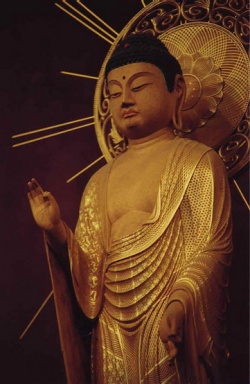Leadership
by Julia Hardy
The Language used by English scholars to describe Buddhist clergy and Buddhist institutions is problematic, in that it is easy to make assumptions based on what that term means in English. Whereas in Catholicism there are priests who preside over Rituals in churches, and Monks who lead contemplative lives in Monasteries, within Buddhism both of these functions are fulfilled within one institution. Scholars, wanderers, the married clergy of Japan, the ascetics — all are usually called "Monks" in English, although on occasion the term "priests" is used. Resorting to indigenous terms is not a satisfactory solution to this problem, as each country has its own Language and categories.
What all of these individuals have in common at first glance is that they wear distinctive robes. The appearance of the robes varies according to region and sect, and there are special robes for those undertaking a particular pilgrimage or feat of asceticism. Regardless of these differences, a member of the Buddhist clergy is always instantly recognizable to the public. All Monks are also bound by the Vinaya, or rules of discipline, although in practice, the degree to which the Vinaya is followed varies.
It is difficult to make generalizations about Buddhist leadership structures. Organizational structures vary from region to region and sect to sect. Some are strictly hierarchical; others are run like a family business. Some have central governing bodies; others do not. Some are aligned with the government; others are oriented toward the community; some serve both.
Given these disclaimers, a few generalizations can be made. There is almost always some kind of hierarchy that may be based on experience or accomplishment. Typically there is one individual in charge of a Buddhist institution, but there are others in positions of significant responsibility. For example, in Japanese Zen temples, the Roshi, or spiritual head, is in charge of teaching novices, but there is also a head Monk who is in charge of the practical business of running the institution. In the large Monasteries, there are many officials in charge of different aspects of a multi-faceted and complex organization.
The duties of clergy toward laypersons are varied. Monks will perform Rituals on request, such as Funerals, and they also conduct the ceremonies on the yearly Ritual Calendar. In a popular temple, Monks might also tell fortunes, sell talismans, or create calligraphic seals for tourists. All the Monks work together to prepare for holiday and festival celebrations. If the Monastery has a school for children or a university, some of the Monks serve as teachers. If it is a Monastery that trains Monks, senior Monks will serve as Meditation teachers, scripture teachers, and so forth. Some Monasteries offer vocational training for the laity; others operate medical clinics. In some Monasteries, the day to day labor-cooking, cleaning, and so forth is done by lay volunteers; in others, particularly in Japanese Zen Monasteries, all the work is done by the Monks.
Even in the modern World, there are still Buddhists who wander alone. Some of these will have a home institution that supports them, others will not. There are other Buddhist clergy who do not live in Monasteries. They may teach at a university that is not affiliated with the Religion, or they may run a non-monastic institution, as do the Taiwanese nuns who run the huge Buddhist Charity Tzu Chi. A few Monks simply choose to live alone and support themselves.
Traditionally there were also traveling teachers who taught Buddhism; these were skilled storytellers who were entertainers as well as teachers. While this practice is rare today, there are now Buddhist teachers who write Books and make television Appearances in which they explain Buddhist views in a public forum and comment on current issues.
This section would not be complete without mentioning that while all Monks are supposed to follow a strict code of discipline and serve as role models for the community, this is an ideal that is not always met. Because of this, a stereotype in popular literature and film in Asia is the Buddhist monk who is stupid, incompetent, lecherous, or immoral. Another stereotype in literature and film is the Monk who has supernatural powers and is able to accomplish amazing feats of magic.
In reality, Monks are a diverse lot, with the same differences in character that one might expect among the general population, or among the leaders of any religious Body. They are distinguished from others only by their choice to devote their lives to Buddhism. They sacrifice the benefits of an ordinary Life to gain the spiritual benefits of their practice and service to the community.
